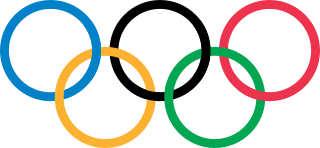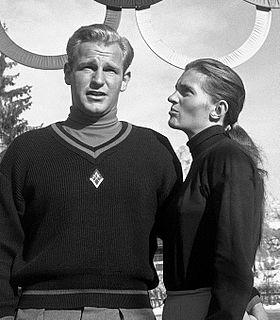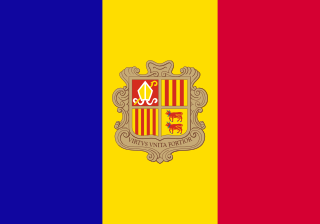
The Winter Olympic Games is a major international multi-sport event held once every four years for sports practiced on snow and ice. The first Winter Olympic Games, the 1924 Winter Olympics, were held in Chamonix, France. The modern Olympic Games were inspired by the ancient Olympic Games, which were held in Olympia, Greece, from the 8th century BC to the 4th century AD. Baron Pierre de Coubertin founded the International Olympic Committee (IOC) in 1894, leading to the first modern Summer Olympic Games in Athens, Greece in 1896. The IOC is the governing body of the Olympic Movement, with the Olympic Charter defining its structure and authority.

The 1952 Winter Olympics, officially known as the VI Olympic Winter Games and commonly known as Oslo 1952, was a winter multi-sport event held from 14 to 25 February 1952 in Oslo, the capital of Norway.

The 1956 Winter Olympics, officially known as the VII Olympic Winter Games and commonly known as Cortina d'Ampezzo 1956, was a multi-sport event held in Cortina d'Ampezzo, Italy, from 26 January to 5 February 1956.
The 1968 Winter Olympics, officially known as the X Olympic Winter Games, was a winter multi-sport event held in Grenoble, France, from 6 to 18 February 1968. A total of 1,158 athletes representing 37 National Olympic Committees (NOCs)—including Morocco's first delegation—participated in 35 events from 10 different sports and disciplines. The team relay (4 × 7.5 km) event in biathlon was contested for the first time.
The 1952 Winter Olympics, officially known as the VI Olympic Winter Games, took place in Oslo, Norway, from 14 to 25 February 1952. A total of 694 athletes representing 30 National Olympic Committees (NOCs) participated in the Games, taking part in 22 events from 6 sports.
At the 1952 Winter Olympics in Oslo, Norway, the six alpine skiing events were held from Thursday, 14 February, to Wednesday, 20 February. The downhill and giant slalom events were held at Norefjell in Krødsherad, Buskerud, and the slalom events at Rødkleiva in Oslo.

Ireland sent a delegation to compete at the 2006 Winter Olympics in Turin, Italy from 10–26 February 2006. This was Ireland's fourth appearance at a Winter Olympic Games. The Irish delegation to Turin consisted of four athletes, two alpine skiers, one cross-country skier, and one skeleton racer. The best performance by any Irish competitor at these Olympics was 20th, by David Connolly in the men's skeleton race.

The U.S. Ski Team, operating under the auspices of U.S. Ski & Snowboard, develops and supports men's and women's athletes in the sports of alpine skiing, freestyle skiing, cross-country, ski jumping, and Nordic combined. Since 1974 the team and association have been headquartered in Park City, Utah.

Andrea Mead Lawrence was an American alpine ski racer and environmentalist. She competed in three Winter Olympics and one additional World Championship, and was the first American alpine skier to win two Olympic gold medals.

Lebanon sent a delegation to compete at the 1952 Winter Olympics in Oslo, Norway from 14–25 February 1952. This was the country's second time competing in a Winter Olympic Games, after their first appearance four years prior. Lebanon was represented in these Olympics by a single alpine skier, Ibrahim Geagea. He competed in three events, and his best finish was 57th in the men's downhill competition.

Andorra sent a delegation to compete at the 2002 Winter Olympics in Salt Lake City, United States from 8–24 February 2002. This was Andorra's seventh consecutive appearance at a Winter Olympic Games. The Andorran delegation consisted of three alpine skiers; Victor Gómez, Alex Antor, and Vicky Grau. Their best performance in any event was 24th place by Grau in the women's slalom.

Rosa "Ossi" Reichert was a German alpine skier. Her greatest victory was in the 1956 Winter Olympics giant slalom at Cortina d'Ampezzo, Germany's sole gold medal at these games. After having seriously injured an ankle in 1954, she was not expected to do well at these games. She also drew the #1 start position for the one-run event. Josefa „Putzi“ Frandl, who won the silver medal in the event, once stated that, "Ossi was disappointed to draw #1 as that was usually not a good position. The first racer down the course usually has to scrape off a bit of snow, which slows you down. But Ossi had a great run and overcame that difficulty."

Dagmar Rom is a former alpine ski racer from Austria. At age 21 she won two gold medals at the 1950 World Championships in Aspen, Colorado, in the slalom and giant slalom events. Two years later she won a silver medal in the giant slalom at the 1952 Olympics.
The men's slalom at the 1952 Winter Olympics was held on Tuesday 19 February at Rødkleiva ski run. The course was very difficult to maintain as the weather was not favorable. The men's course had 52 gates. Since the men's race was scheduled the day before the women's, and there was concern about the condition of the hill, the number of racers was reduced after the first run in compliance with international rules. Twenty-nine athletes finished both runs. Four athletes were disqualified after the first run. Austrian Othmar Schneider won his second Olympic medal, this time gold, after he took the silver in the downhill competition. Norwegians Stein Eriksen and Guttorm Berge placed second and third respectively.

The 1952 Winter Olympics were held in and around Oslo, Norway, from 14 to 25 February 1952. Ten competition and eight non-competition venues were used, in addition to three designated, but unused, reserve competition venues. Six of the competition venues were located in Oslo, while one each was located in Bærum, Skedsmo, Drammen and Krødsherad. Bislett stadion was the centerpiece of the games, hosting the opening and closing ceremonies, the speed skating and the figure skating. Bislett featured both a 400-meter (1,300 ft) circumference speed skating track and a 60-meter (200 ft) long rink used for figure skating, separated by snow banks. Two reserve venues were designated for the skating events, Tryvann stadion in Oslo and Hamar stadion in Hamar.
Antoin Miliordos was a Greek alpine skier who represented his nation at the Winter Olympic Games.

André Bertrand was a Canadian alpine skier who competed in the 1952 Winter Olympics and in the 1956 Winter Olympics.
The Women's giant slalom competition of the Sarajevo 1984 Olympics was held at Jahorina on Monday, February 13. Because of weather delays with the downhills, this was the first alpine event of these Olympics.













